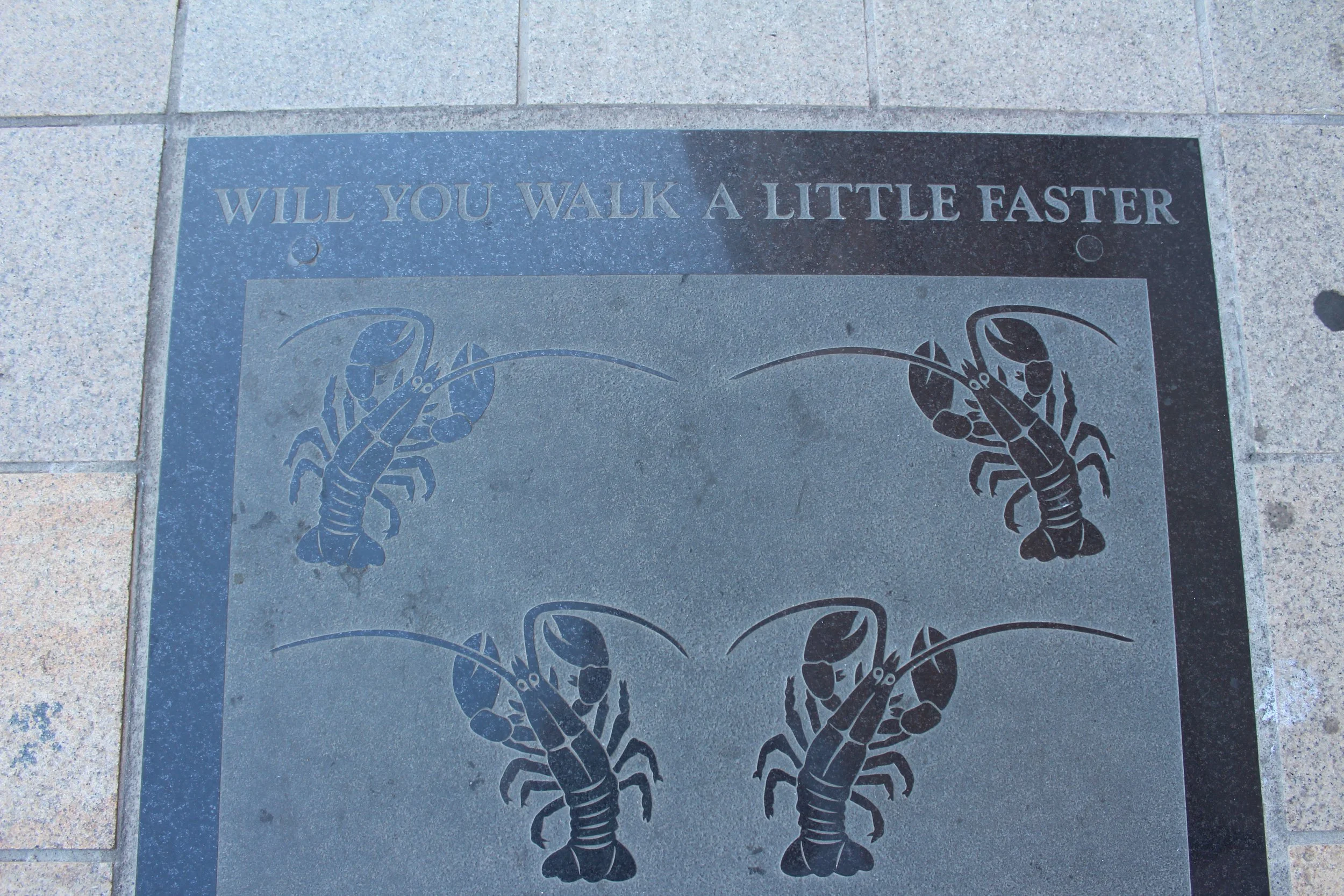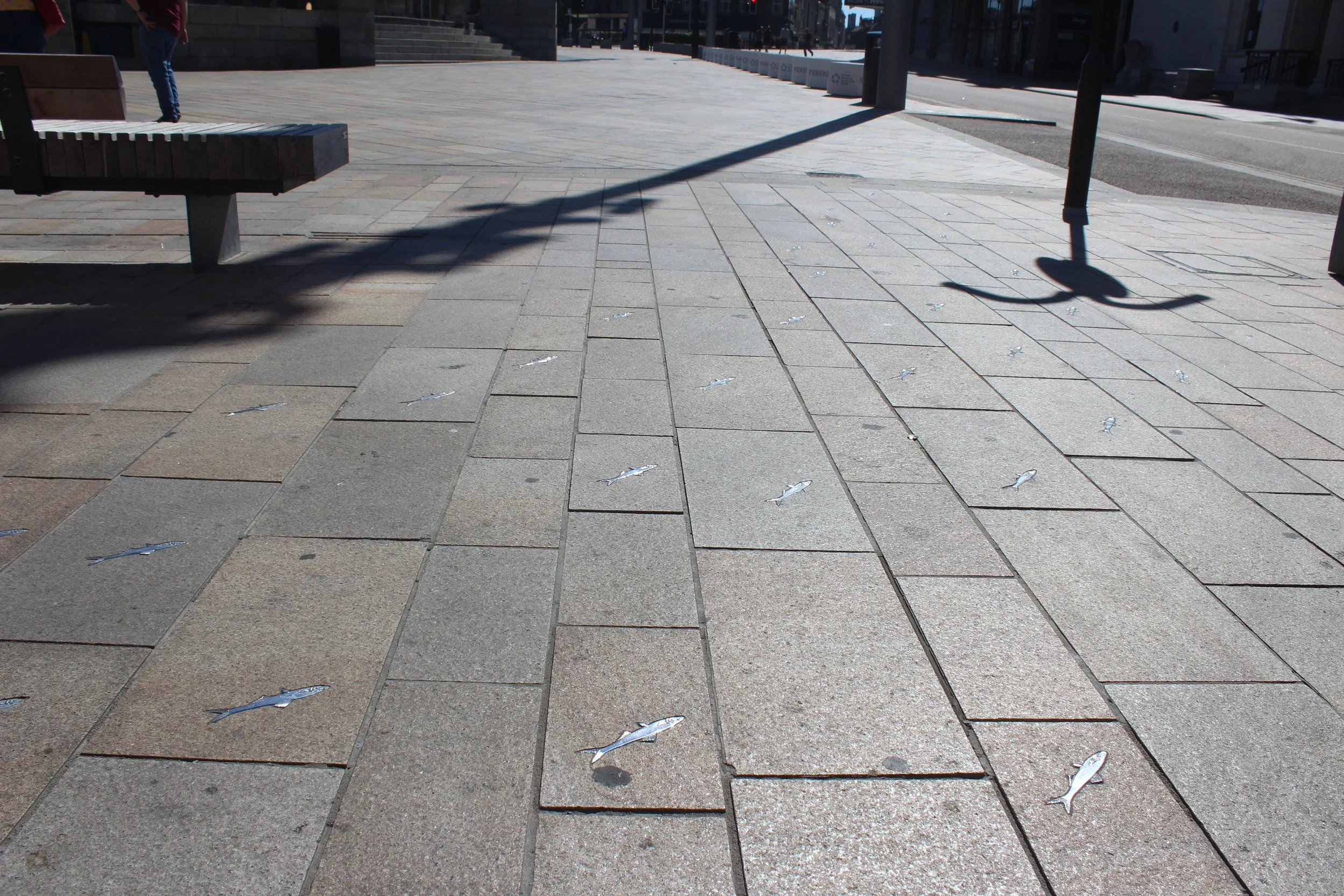Following the Trail
By Patrick Johnson
Lobster on the Trail - ‘Will you walk a little faster?’
Fish. Toads. Moths. Puffins. And coming soon, rats. It is an eclectic mix of creatures, all with one thing in common. They have all been used as symbols for walking trails around Hull and the surrounding area. As pieces of art, they have been representative of the East Yorkshire culture and history, with community groups and local artists often being involved in their design.
The Fish Trail was the first, and it’s the only one that is permanent. Various species of fish are immortalised as tiles or paving slabs on the pavements around Hull city centre. You will have walked over them a thousand times without noticing. Some fish, such as HADDOCK, are recognisable as part of our everyday lives. Others, like the QUID, are more obscure. Be alert for the small ones, such as a shoal of WHITEBAIT swimming next to kerbstones. Larger ones, like the ELECTRIC EEL slithering round a bend, are more obvious.
The Fish Trail was developed in 1992 by artist Gordon Young. Envisaged as a way to promote a walking trail around the scenic parts of Hull, forty-one fish lie in wait for those seeking them. Refurbished for the Millenium in the year 2000, the Fish Trail has seen the streets of Hull change significantly. Pedestrianisation, shops and bars coming and going, empty buildings and major road works have all affected the city centre. The layout of the roads may be basically the same but the atmosphere and vitality have definitely altered.
Clutched in my hand is a map for the route. My eyes alternate between looking at the map and scanning the footpaths for the fish. I start at City Hall, with a shoal of ANCHOVIES pointing in the direction of the trail. On the other side of Victoria Square are the old Dock Offices, better known as the Maritime Museum, which are an instant reminder of Hull’s heritage. Across the road the LOBSTER lurks. “Will you walk a little faster”, a quote from Lewis Carroll’s The Mock Turtle’s Song, urges me on. By the old Beverley Gate, where King Charles 1 was refused entry to Hull, I stand on the COD, staring at the refurbished Burtons Building at the end of Whitefriargate. It is here that I turn towards the river.
Onwards along Princes Dock Street, I leap over the FLYING FISH. Princes Quay dominates the skyline. At the cutting edge of architecture in its day, the shopping centre is now looking dated and tired. Like so many of the shopping areas, it only looks half occupied. I walk over the new footbridge on the A63 and head towards the Humber.
Walking the trail is an opportunity to remember, and perhaps connect to, Hull’s heritage in the fishing industry. Like many people in this area, fishing forms part of my family history. Communities grew around the industry. Once one of the biggest fishing ports in Europe, Hull docks were full of trawlers, with tonnes of fish being landed on the quays. I remember my father telling me tales of mile-long trains leaving from the dockside to take fish to Billingsgate market in London. All this has now virtually disappeared.
The sounds of clanking masts swaying in the breeze ring out as I progress along the marina. Walking past the HADDOCK and around the corner by the Minerva pub, the gusts of wind off the river hit my face. Striding alongside Victoria Pier, the wooden structure jutting out into the dark water of the river, I come to the large RAY, its tail curling round to point in my direction. Stepping on the GARFISH, I reminisce about the old Humber ferry as I pass the Pilot’s Office. Turning right, the cobbles of the High Street, with the promise of more fish, await me.
As I walk, I consider the role of the fishing industry. The catches landed in Hull provided food for thousands of people. I sometimes think that our diet used to be better, fresh fish being a healthy meal. Now we live a world of highly processed food, usually imported from around the world. Is there actually any fish in fish-fingers anymore? But like most things there was a negative side to the fishing industry as well. The vast amounts of fish caught had an environmental impact, with quotas having to be imposed to help stocks replenish.
Leaving behind the High Street I find the JOHN DORY under the arch of St. Mary’s church, well-trodden and faded. A minor sense of frustration builds up as I can’t find what I’m looking for next. A sense of triumph occurs when I discover the fish around the corner. GURNARDS and OARFISH hide in alleyways, like the one leading to Ye Olde White Hart. As I turn past England’s smallest window at the George pub, the smell of Carvers chippie floats by on the breeze, making my mouth water.
Walking is a great way to explore the surroundings. The pace of travel gives that experience of intimacy. Following a historic trail forces me to look properly as I wander along. Buildings, streets and views that I have encountered many times before, and usually ignored, renew themselves in my consciousness. It evokes haunting memories of an era when the old town bustled with activity. I experience a nostalgia for times long gone.
The state of Hull city centre reveals itself as I walk around. The slow decline has taken years but it feels like it is here to stay. The result is empty shops and chewing-gum-stained footpaths. With the advent of online shopping and out-of-town retail parks, the city centre has lost its atmosphere. The big department stores, like Binns and M&S, have disappeared, leaving behind once-grand buildings heading towards dereliction. The vape shops and fast-food joints that have popped up just don’t compare. If there is one thing that extracts the soul from a city, it is empty buildings.
Whitefriargate opens up to reveal busy people, phones in hand, hurrying over the MONKFISH. I stand on it as I tick it off the list. Moving on, I search out others on corners and down lanes, all hidden in plain sight. Further along the SHARK sits outside the old Midland Bank building. Somebody had a sense of humour when it came to the location of this fish. Looking above the shop fronts across the street, I see the old Neptune Inn, with its arched entrance way into a courtyard. I walk up Whitefriargate to the Burton Building. In the distance looms Hull City Hall, the starting point many fishes ago.
Not all the fish symbols still exist. With the huge amount of urban construction works to roads and pavements over the past few years, some have been lost or obscured. It is almost like a metaphor for Hull’s fishing industry. I have mixed emotions about its decline. I’m resigned to the fact that things change, and not always for the better. The problem for Hull is that the fishing industry has never been replaced by anything else as significant.
There is hope that the Fish Trail can be refreshed and invigorated. It is part of the heritage of our city. It might have its issues but Hull is still a great place. Get your shoes on and start walking.
Shiny anchovies at the beginning of the trail

